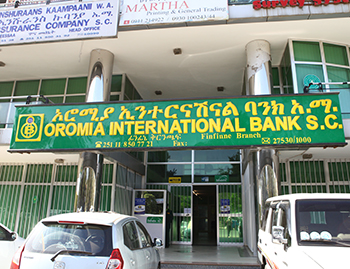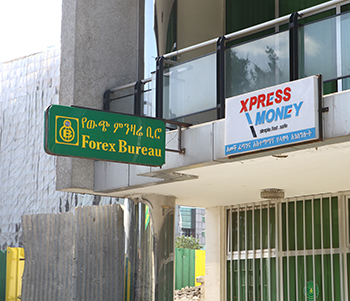Ethiopia banking sector analysis: Ethiopian banks at a crossroads
Ethiopia Sector Analysis
Ethiopia banking sector analysis: Ethiopian banks at a crossroads
Thanks to the firm monetary policy of the National Bank of Ethiopia (NBE), all Ethiopian banks have survived until presence and none has been experiencing symptoms suggesting possible bankruptcy. Ethiopian banks now appear more profitable and ahead of the sub-Saharan standard. Conversely, the sector has to tackle a number of challenges including Ethiopia’s accession to the WTO.

Ethiopia banking sector analysis: Ethiopian banks at a crossroads
By Bewket Abebe
ADDIS ABABA – “I think we do not have a competitive but rather a cooperative advantage,” says Meaza Ashenafi, who is the chairperson of Enat Bank – an Ethiopian privately owned bank established with an intention of empowering women of Ethiopia. Her opinion is not unique; all the other banks in Ethiopia share a very similar belief.
Nonetheless, Ethiopian banking sector seems to be at a crossroads. There is a number of opportunities and conversely a number of challenges.
For Ethiopian banking sector—a sector which used to be traditionally dominated by the state for over half a century—the last two decades brought blessing news. Following the opening up of the sector for private operators in 1994, 16 more banks joined Ethiopian banking sector, which used to be dominated by three state owned banks since 1909.
Given the small size of the market (19 banks) and the population of 93 million there is no doubt the banking segment is experiencing such growth levels.
Thanks to the firm monetary policy of the National Bank of Ethiopia (NBE), all the privately owned banks in the market have survived until presence and none has been experiencing symptoms suggesting possible bankruptcy—contrary to the “disappearance” of a vast number of share companies.
Surveys conducted in the area show that individuals prefer to buy shares in the banks due to the fact that they have more trust in the banking sector than in other sectors in Ethiopia. Consequently, Ethiopian banks began to mobilize more shares and they now appear more profitable and ahead of the sub-Saharan standard.
19 banks for 93 million Ethiopians
Another factor which directly influences the performance and “blossom” of Ethiopian banks is the size of the banking sector. Given the small size of the market (19 banks) and the population of 93 million there is no doubt the banking segment is experiencing such growth levels. In example, the number of bank branches per the number of individuals has been among the lowest in the region. For the 93 million there are only about 1,642 branches across the country.
“Because the size of the banks is very small and the population of the country is very big, there is a huge opportunity for selling services to the public,” explains Abie Sano Mehamed, president of Oromia International Bank (OIB). “Any commodity you bring in you can sell because the consumer market is big.

The banking sector has been performing well in the last few years. Deposits witnessed an average growth of 30% (up to USD 11 billion) and loan collection grew by 16.5% (about USD 940 million). The banks’ returns of capital stood at 55.69% while their return of assets at 3.9%. Loans disbursed by Ethiopian banking sector made up a total of USD 985 million during the 2012/13 fiscal year.
Furthermore, the growing number of middle income households and the vast number of new development projects have also created fertile grounds for the banks. “The supply for financing, even on the domestic side, is also very high because of many infrastructure projects and many factories under construction, but the supply from the bank side cannot keep up with the demand. It is a huge pressure,” says Mehamed. However the banks are on the safe side here: “They (the banks) can easily sell whatever they have,” he adds.
For the time being, the bad loans are not that much risky. “Because of bad loans, there is no such big risk in Ethiopia for considering acquiring the banks. Even though there are bad loans, the size can be managed because we know that the size of bad loans as a whole in Ethiopia is not as worrying as you would think. There is no such threatening situation for the banking sector as a whole because there is a strong regulatory issue for recognizing the bad loans,” claims the president of OIB.

Private vs state owned banks in Ethiopia
What is a bit worrying is the actual proportion of the market shares between the privately and state owned banks. Though the state owned banks are only three (about one sixth of the total number of banks) they still dominate the whole banking system in Ethiopia.
In example, the Commercial Bank of Ethiopia—the largest bank in the country whose assets represent about 70% of the sector—accounts for 67% of total deposits and 55% of loans and advances. The Development Bank of Ethiopia and the Construction and Business Bank of Ethiopia together account for 15.6% of the total capital of Ethiopian banking sector.
The public banks take advantage also in terms of deposit mobilization. In the housing schemes introduced by the government i.e. 10/90, 20/80 and 40/60 (housing schemes, in which customers are expected to save 10% , 20% and 40% respectively for up to five years), only the Commercial Bank of Ethiopia takes the opportunity. In addition, the foreign exchange, which poses a serious challenge for the banks, is monopolized by the NBE given that it supervises all foreign exchange payments and remittances. The state monopoly remains an issue. Among the total disbursement, the state owned Construction and Business Bank alone took the 41%.

In general, the state dominates lending and controls interest rates. As a result, the three banks have started to increase their total assets by up to 21.5% annually. The total debt of the financial enterprises stood at USD 11.73 billion, out of which savings reserve accounts for USD 8.22 billion or 70.09% of the total debt.
The private banks, on the other hand, are expected to pay a 27% Treasury bill requirement while providing loans; and this has frustrated the banks. In this regard, both the Bankers Association and international financial institutions such as the World Bank and the International Monetary Fund have been requesting the Ethiopian government to ease the 27% Treasury bill issue. The government nonetheless resists to do so.
Despite all the opportunities, the banking sector in general and the private banks in particular are struggling with serious challenges such as shortage of foreign currency and shortage of skilled workforce.
According to the 2011 private credit ratio to GDP, the country stood at 9% – much lower than the average of 30% for sub-Saharan Africa. Financial instability—which emanates from negative real interest rates, high reserve money growth, bank-by-bank credit ceilings and the lack of competition in the banking sector—is increasingly becoming an aggregate of those challenges.
Ethiopia’s accession to the WTO

The issue of competitiveness within the sector also seems to be at its infancy level. The sector is lagging in terms of introducing latest technology and others. Out of the total of 19 banks only four of them offer ATM services. Even the existing ATM services are problematic. The services remain more or less embryonic when compared with the neighboring countries.
“We want to collaborate as much as possible with international technology-based institutions to ensure a knowledge transfer,” explains Ashenafi.
In 2013, Ethiopia managed to go up by 48 places on the World Bank’s Doing Business indicator for ‘ease of getting credit’, from 152nd to 104th place out of 185 countries.
The lack of competition, which has become a factor for the survival of the local banks and a source of headache for customers, may persist if the Ethiopian negotiators manage to get a WTO accession without opening up the sector. The bankers themselves understand this clearly. “The strength of the banks will continue until we have to compete with international banks,” concludes Mohamed. Ethiopian banking sector is thus at a crossroads; it has to choose whether to remain competitive within an untapped sector or open up the space for the international banking community.The country is currently striving for its accession to the World Trade Organization. The service offer is delivered to the working party members. The issue of opening up the financial system such as that of the banking has become the toughest one. While trying to address the questions from the US, European Union and Canada, Ethiopian negotiators faced tough times with regard to opening up sectors such as telecom and banking.
FAIR USE POLICY
This material (including media content) may not be published, broadcasted, rewritten, or redistributed. However, linking directly to the page (including the source, i.e. Marcopolis.net) is permitted and encouraged.